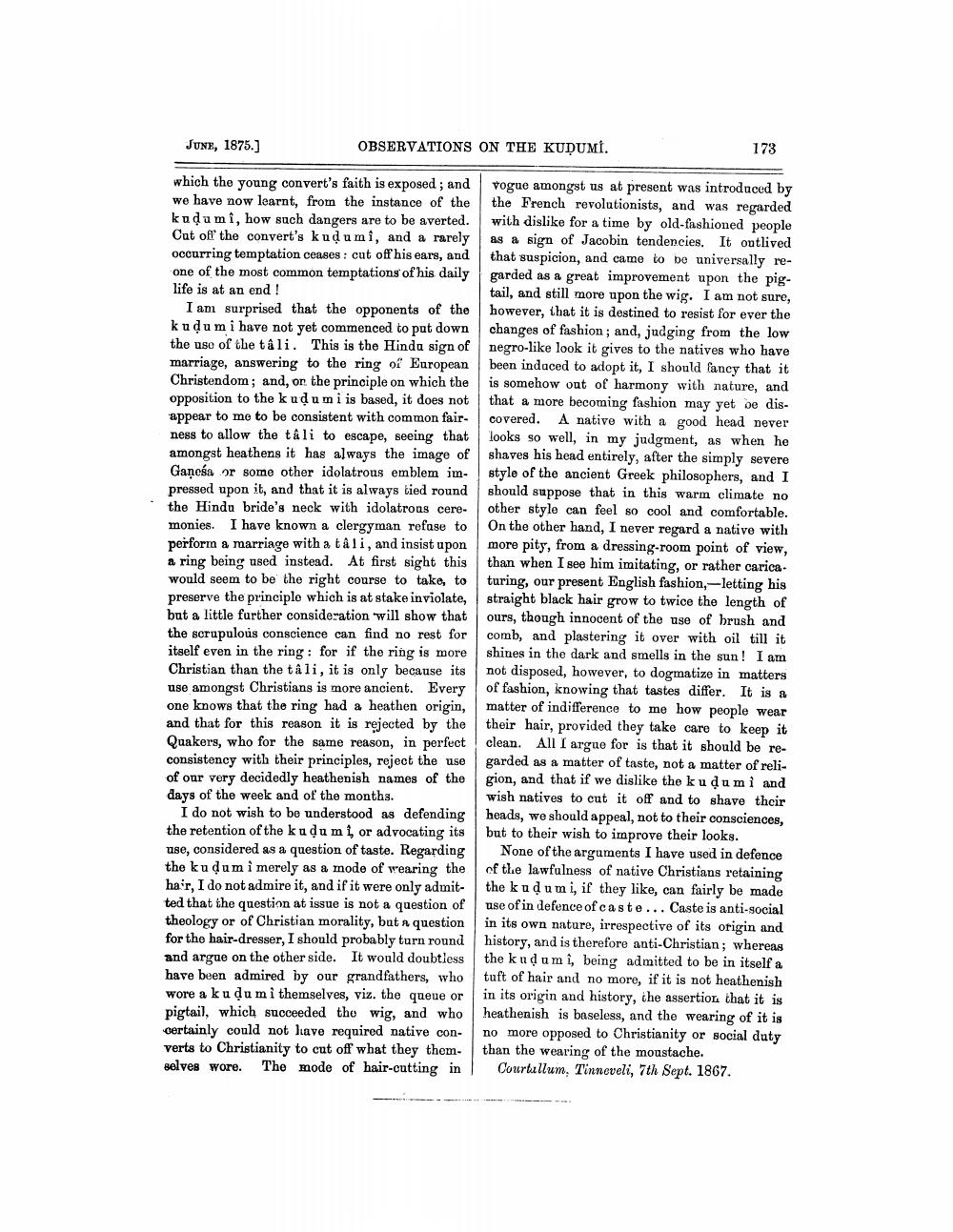________________
JUNE, 1875.)
OBSERVATIONS ON THE KUDUMI.
173
which the young convert's faith is exposed; and we have now learnt, from the instance of the kudumi, how such dangers are to be averted Cat of the convert's kudumi, and a rarely occurring temptation ceases : cut off his ears, and one of the most common temptations of his daily life is at an end !
I am surprised that the opponents of the kudum i have not yet commenced to put down the use of the tali. This is the Hinda sign of marriage, answering to the ring of European Christendom; and, on the principle on which the opposition to the kudu mi is based, it does not appear to me to be consistent with common fairness to allow the tali to escape, seeing that amongst heathens it has always the image of Ganea or some other idolatrous emblem impressed upon it, and that it is always tied round the Hindu bride's neck with idolatrons ceremonies. I have known a clergyman refuse to perform a marriage with a tåli, and insist upon a ring being used instead. At first sight this would seem to be the right course to take, to preserve the principle which is at stake inviolate, but a little further consideration will show that the scrupulous conscience can find no rest for itself even in the ring : for if the ring is more Christian than the tali, it is only because its use amongst Christians is more ancient. Every one knows that the ring had a heathen origin, and that for this reason it is rejected by the Quakers, who for the same reason, in perfect consistency with their principles, reject the use of our very decidedly heathenish names of the days of the week and of the months.
I do not wish to be understood as defending the retention of the kudumi, or advocating its use, considered as a question of taste. Regarding the kudum i merely as a mode of wearing the hair, I do not admire it, and if it were only admit- ted that the question at issue is not a question of theology or of Christian morality, but a question for the hair-dresser, I should probably turn round and argue on the other side. It would doubtless have been admired by our grandfathers, who wore a kudumi themselves, viz. the queue or pigtail, which succeeded tho wig, and who certainly could not have required native con- verts to Christianity to cut off what they them selves wore. The mode of hair-cutting in
vogue amongst us at present was introduced by the French revolutionists, and was regarded with dislike for a time by old-fashioned people as a sign of Jacobin tendencies. It outlived that suspicion, and came to be universally regarded as a great improvement upon the pig. tail, and still more upon the wig. I am not sure, however, that it is destined to resist for ever the changes of fashion; and, judging from the low negro-like look it gives to the natives who have been induced to adopt it, I should fancy that it is somehow out of harmony with nature, and that a more becoming fashion may yet be discovered. A native with a good head never looks so well, in my judgment, as when he shaves his head entirely, after the simply severe style of the ancient Greek philosophers, and I should suppose that in this warm climate no other style can feel so cool and comfortable. On the other hand, I never regard a native with more pity, from a dressing-room point of view, than when I see him imitating, or rather caricaturing, our present English fashion, - letting his straight black hair grow to twice the length of ours, though innocent of the use of brush and comb, and plastering it over with oil till it shines in the dark and smells in the sun! I am not disposed, however, to dogmatize in matters of fashion, knowing that tastes differ. It is a matter of indifference to me how people wear their hair, provided they take care to keep it clean. All I argue for is that it should be regarded as a matter of taste, not a matter of religion, and that if we dislike the kudumi and wish natives to cut it off and to shave their heads, we should appeal, not to their consciences, but to their wish to improve their looks.
None of the arguments I have used in defence of the lawfulness of native Christians retaining the kudumi, if they like, can fairly be made use of in defence of caste... Caste is anti-social in its own nature, irrespective of its origin and history, and is therefore anti-Christian; whereas the kudumi, being admitted to be in itself a tuft of hair and no more, if it is not heathenish in its origin and history, che assertion that it is heathenish is baseless, and the wearing of it is no more opposed to Christianity or social duty than the wearing of the moustache.
Courtullum. Tinneveli, 7th Sept. 1867.




